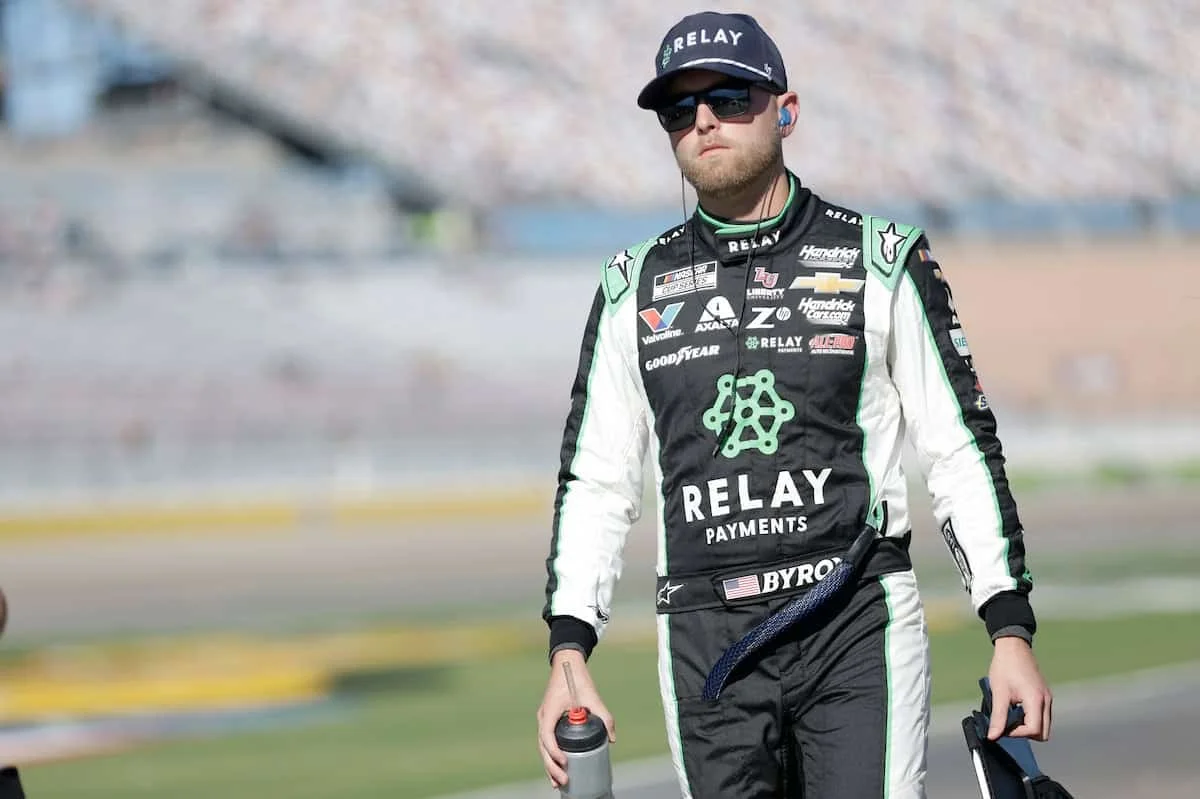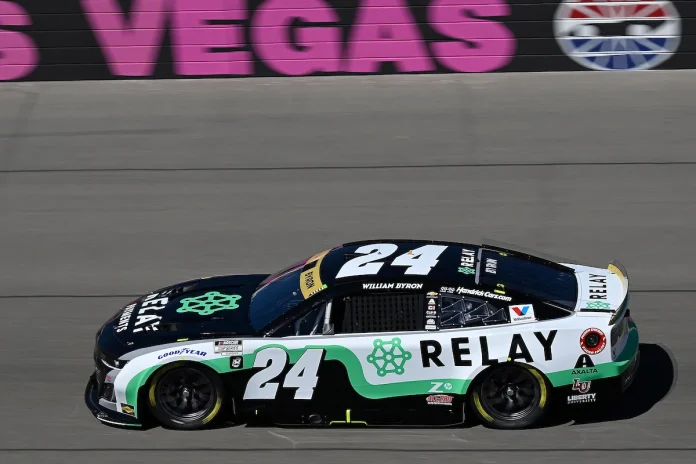The William Byron Las Vegas crash sent shockwaves through the NASCAR community, dramatically impacting the playoff race and prompting immediate reaction from drivers and fans. In the aftermath, Denny Hamlin offered a frank and detailed perspective on exactly what unfolded between Byron and Ty Dillon during the pivotal incident on pit road.
High Stakes and Sudden Turn: The Las Vegas Incident
William Byron appeared ready to reclaim his position at the top as he raced in the Las Vegas playoff, continuously battling for the lead. The scene was set for a thrilling conclusion when, after a small slip in the first turns, Byron regrouped to pursue the leaders. However, his run abruptly ended when contact with Ty Dillon catapulted both cars into an uncontrollable wreck, bringing Byron’s hopes for the day to a devastating close.
This shocking collision, which left Byron’s car severely damaged, rapidly drew heated debates among NASCAR fans and drivers. The central question was what caused such a dramatic failure in communication, and how such disasters could be avoided in the high-adrenaline environment of playoff racing. As speculation mounted, Denny Hamlin stepped in, sharing his experienced insight on the Actions Detrimental podcast to clarify what might have gone wrong.
Denny Hamlin Offers Driver’s Perspective on Crash
The playoff race at Las Vegas Motor Speedway veered off course when Byron, trailing in second, collided with Ty Dillon just as Dillon slowed to enter pit road. Dillon’s entry was not clearly signaled—a crucial mistake, according to Hamlin, that initiated the devastating outcome.

“From what I saw, yes, you want to stay on the banking as long as as you can come to pit road, but he’s up higher. And so what that does, unfortunately for someone like William Byron, is you don’t know if Byron’s looking at the left side door. If even Ty Dillon waved him off, I have no idea whether he did or didn’t,”
Hamlin revealed on the Actions Detrimental podcast.
— Denny Hamlin, NASCAR Cup Series Driver
In NASCAR protocol, ‘waving off’ with a hand signal or spotter cue is vital for safety during pit stops, helping prevent misunderstandings among drivers about when and how to merge or slow down. Communication, whether verbal through the radio or physical with gestures, can mean the difference between a clean entry and a disaster on pit road. Hamlin utilized this opportunity to highlight the necessity for transparent cues, especially in such pressured playoff circumstances.
“My spotter always tells me, ‘Wave blank off. He’s five back.’ I make sure if he doesn’t see my hand, he sees it through the line, my actions, and that is I’m really really low because I don’t want to get wiped out. I sacrifice a little bit of pit entry speed to make sure I don’t get wiped out, if that makes any sense.”
— Denny Hamlin, NASCAR Cup Series Driver
By revealing his own approach, Hamlin illustrated how safety and communication sometimes outweigh competitive speed—an adjustment many racing drivers are forced to make in unpredictable pit road scenarios. According to Hamlin, Ty Dillon was not fully focused on optimizing his pit entry speed, leaving his intentions unclear to trailing competitors like Byron.
Signals and Split-Second Decisions at Pit Entry
Ty Dillon, who was the other driver in the center of the crash with Byron, acknowledged the ambiguous signaling issue during pit entry. Dillon explained the habit among drivers to use hand gestures as a warning, intending to give those behind enough time to react. However, he also admitted that such signals are sometimes missed if not extended consistently or early enough.
“Some people stick their hands out, and I do sometimes to let people know if I’m racing hard with somebody. But I feel like William — the part that I wave out is down the backstretch, he was so far back then that I don’t know if he could see or if I didn’t get it out far enough.”
— Ty Dillon, NASCAR Cup Series Driver
The lack of effective communication—as detailed by both Hamlin and Dillon—appears to have been the catalyst in a moment that derailed both drivers’ races. As the slowdown approached, Byron was left unprepared for Dillon’s reduced pace, resulting in a collision that eliminated their chances and drastically altered the playoff dynamics.
“Ty, I don’t think was running well enough to really be caring about maximizing his entry speed and running halfway up the racetrack.”
— Denny Hamlin, NASCAR Cup Series Driver
Chaos on the Track: Christopher Bell’s Narrow Escape
The ramifications of the Byron-Dillon crash were felt well beyond those directly involved. Christopher Bell, another contender in the playoff race, was running just behind the incident and had to rely on instinct and rapid decision-making to navigate through the unfolding chaos at Las Vegas Motor Speedway.
“Yeah, the 24 [Byron] and 10 [Ty Dillon] was just super scary,”
— Christopher Bell, NASCAR Cup Series Driver
“The sun is really bad off turn four, so you can’t see anything, and yeah, just kind of closed my eyes and hoped that I could get through there, and fortunately, I did.”
— Christopher Bell, NASCAR Cup Series Driver
Bell’s first-hand account highlights the unpredictable dangers present in NASCAR’s playoff races, particularly when visibility is compromised and drivers have only moments to react. The video replay from the event made it clear that the crash left Bell with almost no time to avoid the spinning vehicles in his path. Thanks to quick reflexes, he made it through unscathed, ultimately securing a third-place finish which boosted his playoff standing. Later, Bell would endure yet another mass collision but managed to survive and continue toward the championship hunt.
The dramatic series of events underscores the razor-thin margins drivers operate under and the high risk inherent in each lap, especially as the season edges closer to its conclusion. Every moment of indecision, miscommunication, or missed signal can be the tipping point between disaster and race-saving composure.
The Lasting Impact on NASCAR’s Playoff Picture
The William Byron Las Vegas crash wasn’t just a momentary setback for two competitors. The repercussions were felt up and down the pit lane and across the fan base, fueling ongoing debate about safety, communications, and fair competition. With both Byron and Dillon out, the championship trajectory shifted for several teams, making the remaining playoff rounds even more unpredictable.
As the season heads to its critical final stages, this incident serves as a reminder that every second counts, and thorough communication is essential for both safety and success. The candid reactions from Denny Hamlin and Christopher Bell emphasize how tension and uncertainty pervade every lap of a playoff race. The stakes remain intense, with drivers and their teams scrutinizing every detail to avoid the kind of disaster that unfolded in Las Vegas.
The coming weeks will reveal whether those lessons from the Las Vegas crash lead to improved driver communications and safer pit strategies, standing as a defining moment in this year’s NASCAR Cup Series playoffs.



